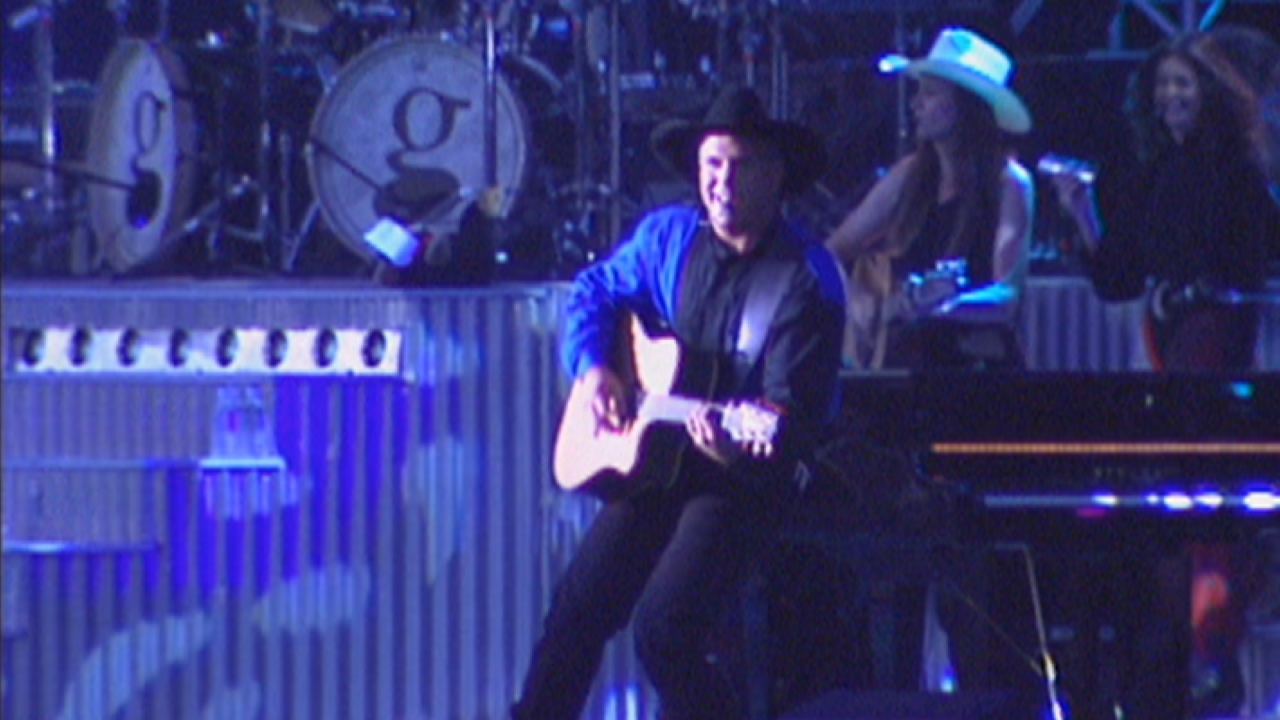It's been 20 years since Garth Brooks joined the ranks of Diana Ross, Elton John and James Taylor, performing live in Central Park in New York City. On Aug. 7, 1997, an estimated 980,000 people crowded the iconic park's North Meadow to watch the country superstar perform a set list of hits, including "Callin' Baton Rouge" and "Friends in Low Places."
Not only was the landmark concert massive in size, it was a showcase of Brooks' vigilant perfectionism and the reliable, demo-crossing appeal he's maintained for years.
In the days leading up to the event, Brooks gave ET some insight into how one mentally prepares for a performance on this scale, which was not only free to concertgoers but being broadcast live on HBO. According to him, he's the kind of person who didn't get nervous before his wedding, but sitting in church the day of was a different story. "All the way up until the preacher stuck his head in and says, 'Alright. Let's go.' And then it was like..." he said with a face full of fear and panic.
"If you see me two seconds before the show I'll be 'meh.' I'll just be hanging out. Having fun [and] probably playing catch or beating up on my little girls or something," Brooks continued. "But, man, the minute I hit that stage, I don't want to look up, because if there's a ton of people there... Sheesh! Who knows what's gonna happen?"
What everything boiled down to: Would the people come? In a city known to have a penchant for rock and roll, classical and jazz, some remained unconvinced of Brooks' ability to pull in what was being hyped by his promoter as 1 million people in attendance. Despite his history of breaking sales records and reputation for garnering fans outside of his country music base, the venue seemed risky to several New York media outlets. Paul Simon's Central Park concert in 1991 had set a high bar, with 600,000 in attendance, for those who tackled the NYC landmark -- not that any fresh standards were needed. Central Park was already famous for amassing crowds in the hundreds of thousands for concerts and appearances from Barbra Streisand, Pavarotti and even the Pope.
"Central Park was really a marriage between a few things," Brooks told ET when the concert was first announced in May of 1997. In the middle of the third leg of a world tour, he had just witnessed fans old and new attending his concerts in droves all over the globe. "The tour has shown me that people still remember who we are and they still show up, so why not bring the tour into New York and do the show here?"
MORE: Garth Brooks Tops Highest-Paid Country Stars of 2017
There are no half-measures when it comes to Brooks, and this concert would be a reflection of that. Later referred by some as "Garthstock," the event would be meticulously planned by the singer's long-time crew to ensure it mirrored the high standards Brooks sets for himself as a performer.
"You gotta get yourself prepared like you're going out in front of 15,000 people in an auditorium somewhere and just realize that it's the show. And my job anywhere I go is to make no matter what size the room as small as I can," Brooks said. "I gotta find a way to get the person in the very back into the show, and that's the challenge that I like."
With a venue of this size and the predicted number of attendees, "challenge" was putting it mildly. The production included the setup and coordination of 24 cameras and a one-of-a-kind camera crane that projected the show onto 5 jumbo screens surrounding the massive, 360-foot long stage.
Of particular interest to Brooks was a camera they had never used before called the "rail cam." Most commonly seen on the sidelines of college basketball games, the remote-operated camera slides along a track, allowing for maximum coverage of the GRAMMY winner as he covered the length of the stage. Brooks said the directors of the show suggested that he should play around with the rail cam during rehearsal to test its potential. The perfectionist who loves challenges remarked with a smile, "I don't think they know what they just told me."
By anyone's measure, the concert was base-level spectacular. Brooks sang several of his most popular hits, such as "The Thunder Rolls" and "Shameless." During "Ain't Goin' Down," Brooks climbed on top of a piano being played by Billy Joel and, later, fellow special guest Don McLean stopped by to perform his signature tune "American Pie" as an encore.
MORE: Garth Brooks Receives the ET Icon Award
"It was so big and it happened so fast, you don't remember a lot of it," Brooks told ET last year, as he was preparing for his big return to New York City, with a tour stop at Yankee Stadium. "Everything was great there, but as far as the show itself it was such a blur."
In May of 1998, the New York City Fire Department announced that 980,000 had attended that night, making it the biggest concert ever. (However, the official number varies from source to source.) By comparison, Ross drew in 800,000 and John attracted 300,000 people. But the bubble of big Central Park concerts had seemingly burst by 2008, when The New York Times reported that fewer than 50,000 people attended Bon Jovi's concert on the Great Lawn, while the 2015 Global Citizen Festival headlined by Beyonce, Pearl Jam and Coldplay only had 60,000 in attendance.
"I never seen so many people in my life," Brooks said, looking back. "Try to remember, in my hometown, when I grew up, [there were] probably 17,000 people. So, to look out and see 40 times your hometown out there, it's like -- it was crazy. It was so beautiful."

